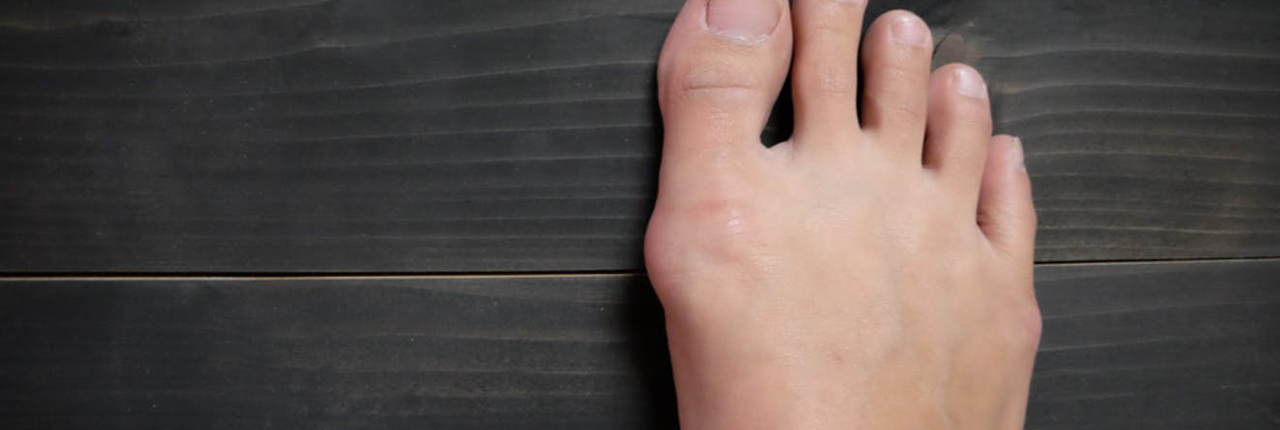Bunions
In general terms, most people think of bunions as a painful bump on the side of their foot. This is true, in part.
It’s a bit confusing, but the word bunion actually refers to three different medical conditions: soft tissue enlargement, hallux abducto valgus and metatarsus primus varus. All three of these problems usually occur together and are what most people think of as a typical “bunion.”
Causes of “Bunions”
- Are shoes to blame? Sometimes.
- Family history of bunions. You do not inherit the bunions, but you inherit the foot type that may lead to bunions. The shape and lenght of your bones in the feet and the way you walk are all inherited.
- Other possible causes of bunions:
- Shoes (especially high-heeled shoes)
- Flat feet (pes planus) and pronation (foot rolls in)
- Metatarsus primus varus (first metatarsal bone rotates)
- Short or long first metatarsal bone
- Round first metatarsal head
- Hypermobility (excess motion) of the metatarsocuneiform joint
- Amputation of the second toe
- Neuromuscular disorders (cerebral palsy, poliomyelitis)
- Rheumatoid arthritis
- Contracture (shortening) of the achilles tendon
- Ruptured posterior tibialis tendon
- Ehlers-Danlos syndrome (hyperelasticity)
Signs & Symptoms of “Bunions”
Bunions are usually termed mild, moderate or severe. Just because you have a bunion does not mean you have to have pain. There are some people with very severe bunions and no pain and people with mild bunions and a lot of pain.
- Pain, swelling or redness on the inside of your foot at the big toe joint
- Numbness or burning in the big toe
- Pain while wearing shoes – especially shoes too narrow or with high heels
- Pain during activities
Diagnosis & Tests
Your podiatrist will ask you questions about the symptoms you are having while examining your foot. You will also probably be asked to stand and walk barefoot to further assess your foot function. The presence of a bunion is usually obvious, but sometimes there is more going on than just a bunion, so your podiatrist may request an x-ray. Bunions are usually termed mild, moderate or severe. Bunions can start out mild and progress to severe. There is no clear-cut way to predict if a bunion will get worse. The severity of the bunion and the symptoms you have will help determine what treatment is recommended for you.
Treatment for “Bunions”
Conservative (non-surgical) treatment will not make the bunion go away, but it will hopefully decrease the signs and symptoms you have and help you get rid of the pain and get you back to your activities. These 5 recommended products for bunions also may help.
- Wider shoes
- Extra depth shoes
- Stretch shoes (where the bunion is)
- Ice
- Padding, splints, toe spacers
- Custom orthoses (orthotics)
- Change in activities
- Physical therapy
Surgical treatment for bunions is sometimes needed. If you are limited by pain, cannot fit in shoes comfortably and are not able to do your daily activities, then surgery may be a good option for you. There are many different surgical procedures to repair bunions. Your podiatrist will review your foot exam findings, your x-rays, your age, your health, your lifestyle, your physical activity level and discuss with you which procedure he or she would recommend
Prevention of “Bunions”
- Do not wear high heels if there is a family history of bunions
- Wear shoes that have enough width and depth in the toe box
- Use a orthotics if you over-pronate (foot rolls in)
Written by Karl Lockett
Bunions
In general terms, most people think of bunions as a painful bump on the side of their foot. This is true, in part.
It’s a bit confusing, but the word bunion actually refers to three different medical conditions: soft tissue enlargement, hallux abducto valgus and metatarsus primus varus. All three of these problems usually occur together and are what most people think of as a typical “bunion.”
Causes of “Bunions”
- Are shoes to blame? Sometimes.
- Family history of bunions. You do not inherit the bunions, but you inherit the foot type that may lead to bunions. The shape and lenght of your bones in the feet and the way you walk are all inherited.
- Other possible causes of bunions:
- Shoes (especially high-heeled shoes)
- Flat feet (pes planus) and pronation (foot rolls in)
- Metatarsus primus varus (first metatarsal bone rotates)
- Short or long first metatarsal bone
- Round first metatarsal head
- Hypermobility (excess motion) of the metatarsocuneiform joint
- Amputation of the second toe
- Neuromuscular disorders (cerebral palsy, poliomyelitis)
- Rheumatoid arthritis
- Contracture (shortening) of the achilles tendon
- Ruptured posterior tibialis tendon
- Ehlers-Danlos syndrome (hyperelasticity)
Signs & Symptoms of “Bunions”
Bunions are usually termed mild, moderate or severe. Just because you have a bunion does not mean you have to have pain. There are some people with very severe bunions and no pain and people with mild bunions and a lot of pain.
- Pain, swelling or redness on the inside of your foot at the big toe joint
- Numbness or burning in the big toe
- Pain while wearing shoes – especially shoes too narrow or with high heels
- Pain during activities
Diagnosis & Tests
Your podiatrist will ask you questions about the symptoms you are having while examining your foot. You will also probably be asked to stand and walk barefoot to further assess your foot function. The presence of a bunion is usually obvious, but sometimes there is more going on than just a bunion, so your podiatrist may request an x-ray. Bunions are usually termed mild, moderate or severe. Bunions can start out mild and progress to severe. There is no clear-cut way to predict if a bunion will get worse. The severity of the bunion and the symptoms you have will help determine what treatment is recommended for you.
Treatment for “Bunions”
Conservative (non-surgical) treatment will not make the bunion go away, but it will hopefully decrease the signs and symptoms you have and help you get rid of the pain and get you back to your activities. These 5 recommended products for bunions also may help.
- Wider shoes
- Extra depth shoes
- Stretch shoes (where the bunion is)
- Ice
- Padding, splints, toe spacers
- Custom orthoses (orthotics)
- Change in activities
- Physical therapy
Surgical treatment for bunions is sometimes needed. If you are limited by pain, cannot fit in shoes comfortably and are not able to do your daily activities, then surgery may be a good option for you. There are many different surgical procedures to repair bunions. Your podiatrist will review your foot exam findings, your x-rays, your age, your health, your lifestyle, your physical activity level and discuss with you which procedure he or she would recommend
Prevention of “Bunions”
- Do not wear high heels if there is a family history of bunions
- Wear shoes that have enough width and depth in the toe box
- Use a orthotics if you over-pronate (foot rolls in)



